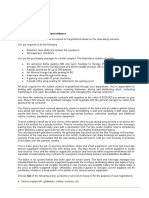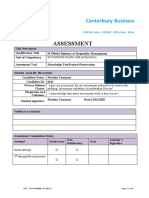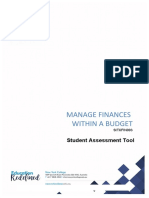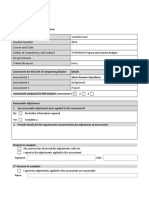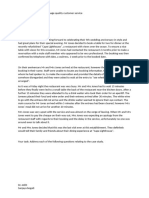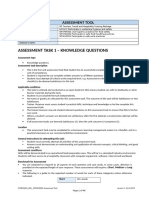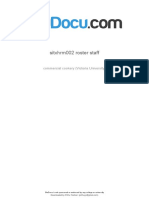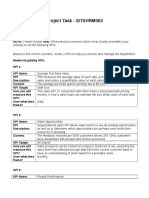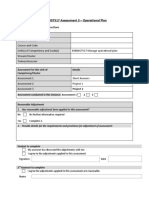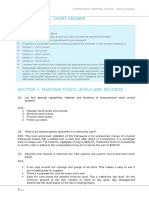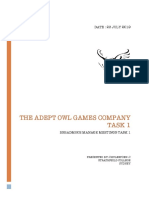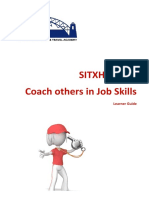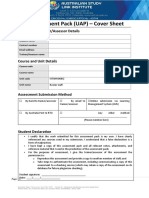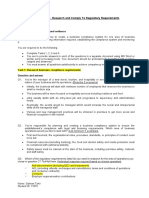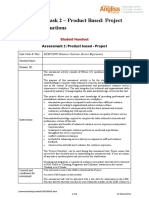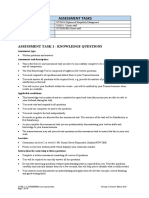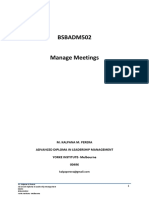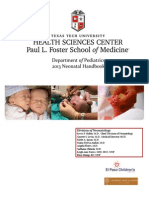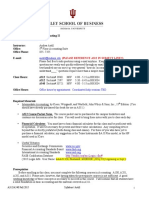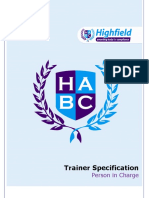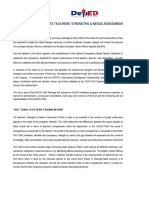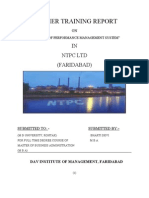Assessment For Roster CCHD 2.3 SITXHRM002 at 44030
Assessment For Roster CCHD 2.3 SITXHRM002 at 44030
Uploaded by
Mmc MixCopyright:
Available Formats
Assessment For Roster CCHD 2.3 SITXHRM002 at 44030
Assessment For Roster CCHD 2.3 SITXHRM002 at 44030
Uploaded by
Mmc MixOriginal Description:
Original Title
Copyright
Available Formats
Share this document
Did you find this document useful?
Is this content inappropriate?
Copyright:
Available Formats
Assessment For Roster CCHD 2.3 SITXHRM002 at 44030
Assessment For Roster CCHD 2.3 SITXHRM002 at 44030
Uploaded by
Mmc MixCopyright:
Available Formats
ASSESSMENT TASKS
Qualification: SIT50416 Diploma of Hospitality Management
Cluster number and name: CCHD 1.2 Roster staff
Units of competency: SITXHRM002 Roster staff
Student’s ID and name: 44030
Assessor’s name: Daniel Sussmann
ASSESSMENT TASK 1 - KNOWLEDGE QUESTIONS
Assessment type:
Written questions and answers
Assessment task description:
This is the first (1) unit assessment task you have to successfully complete to be deemed competent in this
unit of competency.
The Unit Knowledge Test is comprised of eighteen (18) written questions.
You must respond to all questions and submit them to your Trainer/Assessor.
You must answer all questions to the required level, e.g. provide the number of points, to be deemed
satisfactory in this task.
You will receive your feedback within two weeks - you will be notified by your Trainer/Assessor when
results are available.
Applicable conditions:
This knowledge test is untimed and are conducted as open book tests (this means you are able to refer to
your textbook during the test).
You must read and respond to all questions.
You must use computers to answer the questions.
You must complete the task independently
No marks or grades are allocated for this assessment task. The outcome of the task will be Satisfactory or
Not Satisfactory.
As you complete this assessment task you are predominately demonstrating your written skills and
knowledge to your trainer/assessor.
The trainer/assessor may ask you relevant questions on this assessment task to ensure that this is your own
work.
Location:
Classrooms on level 2 or level 6 / 401 Sussex Street Haymarket, Sydney NSW 2000
Please access your student portal which displays your classroom number.
Instructions for answering written questions:
Complete a written assessment consisting of a series of questions.
You will be required to correctly answer all the questions.
Do not start answering questions without understanding what is required from you. Read the questions
carefully and critically analyse them for a few seconds, this will help you to identify what is really needed.
Your answers must demonstrate an understanding and application of relevant concepts, critical thinking,
and good writing skills.
CCHD_3.2_SITXHRM002 Assessment tasks Version 2 Issued 4 March 2019
Page 1 of 38
ASSESSMENT TASKS
Qualification: SIT50416 Diploma of Hospitality Management
Cluster number and name: CCHD 1.2 Roster staff
Units of competency: SITXHRM002 Roster staff
Student’s ID and name: 44030
Assessor’s name: Daniel Sussmann
Be concise to the point and write answers according to the given word-limit to each question and do not
provide irrelevant information. Be careful, quantity is not quality.
Be careful to use non-discriminatory language. The language used should not devalue, demean, or exclude
individuals or groups on the basis of attributes such as gender, disability, culture, race, religion, sexual
preference or age. Gender inclusive language should be used.
When you quote, paraphrase, summarise or copy information from the sources you are using to write your
answers/research your work, you must always acknowledge the source.
How your trainer/assessor will assess your work?
This assessment task requires the student to answer all the questions.
Answers must demonstrate the student’s understanding and knowledge of the unit.
If all assessment tasks are deemed Satisfactory (S), then the unit outcome is Competent (C).
If at least one of the assessment task is deemed Not Satisfactory (NS), then the unit outcome is Not Yet
Competent (NYC).
Purpose of the assessment task:
This assessment task is designed to evaluate your Knowledge for the following:
Knowledge to develop roster based on relevant industrial agreements, other considerations and wage
budgets to maximize operational and customer service efficiency while keeping the wage costs to
minimum.
Knowledge to combine duties where appropriate and roster teams with complementary skills mix to meet
operational requirements.
Knowledge to take account of social and cultural considerations and broader organizational policies
affecting staff rosters.
Knowledge to consult with colleagues for input on roster and use roster systems and equipment to
administer them.
Knowledge to present and communicate roster in required formats with clarity of information based on
organizational standards to the appropriate colleagues with in designated timeframes.
Knowledge to administer records of shift time of staff and maintain rostering records according to
organizational procedures.
Knowledge to monitor effectiveness of rosters in consultation with colleagues and identify and implement
improvement areas for the roster and roster development processes.
Reading skills to interpret documents outlining opening and closing times, operational hours, and expected
customer traffic.
Written skills to write potentially complex roster documentation.
Oral/speech communication skills to get input from colleagues on the requirements, listen, understand and
interpret message from them.
Numeracy/numbers- mathematical skills to interpret/understand mathematical data when reviewing and
analysing scenario/setting-situation business information.
CCHD_3.2_SITXHRM002 Assessment tasks Version 2 Issued 4 March 2019
Page 2 of 38
ASSESSMENT TASKS
Qualification: SIT50416 Diploma of Hospitality Management
Cluster number and name: CCHD 1.2 Roster staff
Units of competency: SITXHRM002 Roster staff
Student’s ID and name: 44030
Assessor’s name: Daniel Sussmann
Problem solving knowledge to rework rosters in case of staff illness.
Knowledge to work collaboratively/together to consider staff requests and personal commitments when
planning rosters.
Knowledge to sequence/in order and schedule/plan activities and manage communication.
Resources required to complete the assessment task:
Computer
Internet
MS Word
Printer or e-printer
Adobe acrobat/reader
Learning management system
Virtual organisations and scenarios
Benchmark for Assessment
You are expected to respond to all aspects of each question and case study. In some cases, direction is
provided on the expected length of your response. These assessments will require a Short, Medium or Long
response.
The following is a guide to the expected number of words for each of these categories unless otherwise
indicated.
Short 30+ words
Medium 150+ words
Long 300+ words
Questions:
1.1. Explain the importance of industrial agreements and other considerations, as well as, wage budgets
when developing rosters. Answer MEDIUM.
Industrial agreement and consideration may relate to mandate breaks between shifts, maximum allowed shift
hours, standard overtime and penalty pay rates, overall number of hours allocated to different staff members.
CCHD_3.2_SITXHRM002 Assessment tasks Version 2 Issued 4 March 2019
Page 3 of 38
ASSESSMENT TASKS
Qualification: SIT50416 Diploma of Hospitality Management
Cluster number and name: CCHD 1.2 Roster staff
Units of competency: SITXHRM002 Roster staff
Student’s ID and name: 44030
Assessor’s name: Daniel Sussmann
Contractors and consideration of fees, allocating permanent or casual staff.
Wage Budget importance when developing roasters: it allows companies to design rosters, model costs, and
easily compare actuals to planned expenditure. Displaying costs while developing the roster assists managers
to take control of their labour costs and enforces a budget responsibility before finalising rosters
It is the guideline of how much money we can spend on roaster at particular time periode.
The idea is to have efficient service and operation with the least amount of staff.
Busy period also requires additional people/re-enforcement
1.2. How can a roster help organisation to maximise operational and customer service efficiently while
minimising wage costs? Answer MEDIUM
Rosters have information about expected duties to be performed and total number of employees required
for performing these duties. Than it helps in doing proper human resource planning and skilled persons
may be given the task of performing duties. Than roster helps in prohibiting overlapping of duties and
employees can provide best services and outputs,
Assigning combined job role to the all rounder staff/multitasking staff member.
Best practices would be to utilize “all rounder staff” especially during quitter periods.
During busy period specialized staff should be used to ensure each position is filled by a more
capable staff member who will increase efficiency during the rush times.
Previous roster and wage budgets can be analysed to identify when the busy or quiet period are
generally expected. This allows for better management of the roster.
1.3. During preparation of a roster, how can combining duties of staff members increase effective use of
staff? Answer SHORT to MEDIUM
It is always a profitable for the businesses to assign combined job roles to allrounder and multitasking
staff member which will allow them to do combined duties when required. This will same money on
wage budget. For example: a bartender can take order, run drinks to table/ or even process the payment.
A host can work both reception and run food/drink to the table etc.
1.4. Team rosters should comprise of staff with complementary mix of skills, to meet operational
requirements. Detail the rationale and truth of this statement, in 100 – 150 words.
I believe that every company/organisation needs a strong team to be successful, however, I feel that “strong”
needs to be complemented by “different”. Hiring people that have different skills and strengths than any
member of team is difficult, but important to do coaching and training to get the team member to a place
where they can truly perform their best multitask and even do the combined job roles. Further supporting
points are:
In all cases the idea is to have an efficient team.
Some staff will bring a mixture of skills to the work place and staff should be rostered to ensure the
entire job can be done properly and efficiently using all of the skills for example: In a kitchen you
CCHD_3.2_SITXHRM002 Assessment tasks Version 2 Issued 4 March 2019
Page 4 of 38
ASSESSMENT TASKS
Qualification: SIT50416 Diploma of Hospitality Management
Cluster number and name: CCHD 1.2 Roster staff
Units of competency: SITXHRM002 Roster staff
Student’s ID and name: 44030
Assessor’s name: Daniel Sussmann
could have several stations such as meat, salad, fryer etc. and each member operating their section
would know how to do this role properly and efficiently. Together the team is able to create a
complete dish in the most efficient way.
In some cases, these teams’ members don’t just work together to complete the job but they may also
impart their knowledge and skills to the other team members to further improve the overall quality
and efficiency of the team.
1.5. Write briefly in 50 – 100 words each, the impact of following in staff rosters:
Social and cultural considerations
Broader organisational policies
Social and cultural considerations
Managers need to take into the consideration of social and cultural importance/requirement of the staff
member when making a roster. It is important to know the social obligation of staff member which will
affect their availability of work and days/timing. The manager needs to make sure that they are not
hindering those obligations/commitments. Eg: single parents need to drop off/ pick up kids from school
they can only able to work between those hours. Students can only able to work certain nights and during
holidays. staff with less family responsibilities are happier to more nights shift and weekends. Casual and
part-time workers often need to manage other commitments such as university,
Cultural consideration may include making sure that staff with religious/culture faith get the days off on
the special religious cultural festival. Eg: x-mass, ramadan, dewali, chinese new year, etc.
Some of the benefits a business can avail by mixing staff from different cultural backgrounds on roster
are-
• Diverse cultural perspectives can inspire creativity and drive innovation
• Local market knowledge and insight makes a business more competitive and profitable
• Cultural sensitivity, insight, and local knowledge means higher quality, targeted marketing
• Drawing from a culturally diverse talent pool allows an organization to attract and retain the best talent
Broader organisational policies
The organisation must have appropriate governance structures in place to oversee roster planning,
creation, approval, monitoring and reporting. Rosters must conform to relevant regulatory frameworks,
including anti-discrimination, work health and safety legislation, industrial awards, as well as things like
maternity leave will also affect rostering. These staff have a right to take extended leave but have their
job “saved” or “reserved” for them when they return to workforce. If this occur business has 2 main
options:
1. Have existing staff cover the shifts or
2. Hire a temp for the expected period of leave
1.6. Explain any three (3) ways to consult and or gain input of, colleagues regarding rosters. Answer
SHORT
CCHD_3.2_SITXHRM002 Assessment tasks Version 2 Issued 4 March 2019
Page 5 of 38
ASSESSMENT TASKS
Qualification: SIT50416 Diploma of Hospitality Management
Cluster number and name: CCHD 1.2 Roster staff
Units of competency: SITXHRM002 Roster staff
Student’s ID and name: 44030
Assessor’s name: Daniel Sussmann
Making sure there is enough time for upcoming personal plan/commitment of staff to be fixed by
sending roster well in advance. Try to arrange staff around these commitments so there is less likely
to be clash or a need to redo or change the roster.
Give staff incentives and responsibilities for their shift. Those who always says “yes” to a shift will
always be the first priority when additional shift arises. Allow for some casual staff to choose “set
days” but make them responsible for replace for if they are unable to work their regular days and
make sure they are aware that the any person who replaces them must have the same skill sets.
Requesting Timely submission of relevant paperwork, such as forms for providing evidence of
additional hours worked and leave applications
1.7. Explain roster systems and equipment that can be used by an organisation to administer roster
management. Answer in 75 to 100 words
List any three (3) roster systems and three (3) types of equipment available in the market.
List any six (6) system capabilities and functions required in rostering software.
Rostering Software can help eliminate the difficulties related to roster building, shift availability, and
shift management. Create complex rosters and reduce admin costs. With the use of modules designed to
simplify roster building and management. They can also help management identify log in and log out time
of staff which can then also integrate with payroll system.
Some examples of these types of technology includes:
Appointment plus
Tanda rostering
Roster portal
Riteq rostering
Some types of equipment that can be used are:
Biometric time clock, Proximity time clock, USB Fingerprint Scanner, Web based clocking.
Rostering software programs.
Pos system are being used to integrate roster management
Biometric logins are also being used with more complicated systems,
Six Capabilities and functions of these system can include:
They can track login, log out and break times.
Automation of rostering through history.
Helps to calculate total hours used over a period which can then be give a potential budget or
projection for that period.
Some system allows staff to swap shifts amongst themselves without having to gain approval from
the management. As well as Identify a need for specific skill sets or area that need to be filled
They can assist the staff to apply for or be approved for leave or sick days.
CCHD_3.2_SITXHRM002 Assessment tasks Version 2 Issued 4 March 2019
Page 6 of 38
ASSESSMENT TASKS
Qualification: SIT50416 Diploma of Hospitality Management
Cluster number and name: CCHD 1.2 Roster staff
Units of competency: SITXHRM002 Roster staff
Student’s ID and name: 44030
Assessor’s name: Daniel Sussmann
Potential to integrate into payroll and invoicing
1.8. Mention any four (4) ways to present and communicate rosters in required, clear formats, to appropriate
staff within designated timeframes. Your answer should include both electronic and paper based
methods. Answer in 3-5 lines for each.
Roster communication is very important to companies because it allows companies to be productive and
operate effectively. Employees can have the opportunity of providing you with the feedback and it can
help increase their morale, productivity and commitment if they are able to communicate up and down
the communication chain in an organization.
In general, an employer should give at least 2 weeks advance roster to all full time and part time staff,
casuals may also be part of the roster if they work on temporary for regular shifts. Other casuals are
usually just called in.
Send weekly Email correspondence to all employees in the company.
Whats app/messenger Social media can also be an effective way to deliver rosters
Some of the roster system and programs have an automated SMS system for staff shifts
Distribute physical copies of the roster to the staff
Printed roster on the notice board.
Further points can be:
By email- Staff Rosters can be send out via email. There is so many different software available where
we update our staff database with their email address. These can be used to send out rosters to each of
our staff member in one click.
Noticeboard- This is the most traditional way of communicating rosters with our staff. Where the rosters
could be printed in a piece of paper and put on the notice board in tea room or roster may be written on
the notice board itself.
Paper based- This is another commonly used roster communication method. This is very similar to the
noticeboard method however in this case staff may have been given a hard copy of the roster in person
1.9. Explain paper based and electronic formats that organisations use to maintain staff rostering records, to
administer shift times of employees and/or contractors. Answer LONG.
Everyone in business must keep records. Keeping good records is very important to our business. The
businesses need good rostering records to monitor the progress of their business. Records can show
whether the business is improving, which team member is working effectively, or what changes the
business need to make.
1. Paper based: ( time sheets) It is a printed piece of a paper with the company’s logo or details in it.
Staff utilises this to record their time of work in order to get paid. Every organisation has its own
policies and procedures. They must ensure that rostering records are kept hour worked for all
CCHD_3.2_SITXHRM002 Assessment tasks Version 2 Issued 4 March 2019
Page 7 of 38
ASSESSMENT TASKS
Qualification: SIT50416 Diploma of Hospitality Management
Cluster number and name: CCHD 1.2 Roster staff
Units of competency: SITXHRM002 Roster staff
Student’s ID and name: 44030
Assessor’s name: Daniel Sussmann
employees, not just the ones in the rosters which could be full time and part time only eg casuals. If
records aren’t kept or are incorrect, fair work inspectors can give employers a fine, called an
infringement notice.
A copy of the written agreement if the employer and employee have agreed to an averaging
of the employee's work hours.
Small business generally uses a paper-based system. They are simple and easy to manage
and do not over complicate the roster process.
Rosters are printed and are either handed out or posted on a notice board
Typically staff shift are also put into a paper register or log in or log out register.
Very cost-effective method
Not very time consuming
Not much training is required to write or understand these systems.
2. Electronic based:
These are systems generally used by big business that employ many staff who utilise many
different skills sets. They require close attention to detail to ensure the roster utilise the
most appropriate staff in the most efficient team but in a cost-effective manner.
These rosters would be distributed using online platforms such as emails or apps such as
WhatsApp etc.
These systems require specific software which is generally expensive to buy.
These system and software are generally very complicated and will sometimes require
additional training to operate them efficiently.
They can be automated.
1.10. Explain any six (6) steps to monitor effectiveness of rosters and identify areas of improvement, in
roster development, with consultation from colleagues. Answer in 3-5 lines for each.
A good roster plan ensures that each shift has enough employees to keep things running smoothly and
efficiently. A good employee schedule also prevents anyone from getting into an accident at work
because of exhaustion, which means your roster plan can also be reinforced to keep your employees safe
and healthy. A great employee shift schedule also prevents disorganization and wastefulness.
(regular employee performance reviews, team meeting, suggestion box, regular employee surveys)
Consider first the job that needs to be done and the required workload to complete the job
Assign each staff members based on their skills sets and availability.
Give as much time as possible for staff to look at the roster and identify any need for changes before
finalisation.
Closely monitor staff log in and log out time including breaks.
Make sure to double check things such as sick days leave or shift swaps to ensure the shifts are filled
by the correct skill sets.
Feedback from customers and staff can identify if the roster was effective in providing effective
CCHD_3.2_SITXHRM002 Assessment tasks Version 2 Issued 4 March 2019
Page 8 of 38
ASSESSMENT TASKS
Qualification: SIT50416 Diploma of Hospitality Management
Cluster number and name: CCHD 1.2 Roster staff
Units of competency: SITXHRM002 Roster staff
Student’s ID and name: 44030
Assessor’s name: Daniel Sussmann
service.
Monitor and check with HR in regards to the cost versus revenue to see if the roster is financially
viable and cost effective.
1.11. List any three (3) sources of information on awards and other industrial provisions.
Following are:
Fair work Australia www.fairwork.gov.au
NSW awards www.fairwork.gov.au/awards
NSW industrial relations Commissions www.irc.justice.nsw.gov.au
1.12. Assume you are working in a restaurant as a casual employee. Access the applicable award and record
the details surrounding based on Restaurant Industry Award 2010 for following:
a. Leave provisions
b. Mandated breaks between shifts
c. Maximum allowed shift hours
d. Standard, overtime and penalty rates
Answer LONG
a. Leave provisions:
leave entitlement - Annual leave is provided for in the national employment standards. It
does not apply to casual employee based on the restaurant industry awards 2010. for the
purpose of the additional week of leave provided by the NES, a shift worker is a seven day
shift worker who is regularly rostered to work on Sundays and public holidays in a business
in which shifts are continuously rostered 24 hours a day for seven hours a shift.
Payment for annual leave: The New prescribes the basis for payment for annual leave,
including payment for untaken leave upon the termination employment. In addition to the
payment provided for in the NES, an employer is required to pay and additional leave
loading 17.5% of that payment.
Close- down: An employer may require an employee to take annual leave as part of a close-
down of its operations, by giving at least four weeks 'notice.
Annual leave in advance: an employer and employee may agree in writing to the employee
taking a period of paid annual leave before the employee has accrued an entitlement to the
leave.
b. Mandated breaks between shifts
Column 1 Column 2
Ordinary Hours worked Breaks
per day
5 or more and up to 10 An unpaid meal break of at least 30 minutes (to be taken after the first
hour of work and within the first 6 hours of work or in accordance with
clause 32.4).
CCHD_3.2_SITXHRM002 Assessment tasks Version 2 Issued 4 March 2019
Page 9 of 38
ASSESSMENT TASKS
Qualification: SIT50416 Diploma of Hospitality Management
Cluster number and name: CCHD 1.2 Roster staff
Units of competency: SITXHRM002 Roster staff
Student’s ID and name: 44030
Assessor’s name: Daniel Sussmann
If the employee is rostered to take an unpaid meal break later than 5
hours after starting work,one additional 20 minute paid meal break (to
be taken after the first 2 hours of work and within the first 5 hours of
work).
More than 10 An unpaid meal break of at least 30 minutes (to be taken after the first
hour of work and within the first 6 hours of work or in accordance with
clause 32.4).
If the employee is rostered to take an unpaid meal break later than 5
hours after starting work,one additional 20 minute paid meal break (to
be taken after the first 2 hours of work and within the first 5 hours of
work).
2 additional 20 minute paid rest breaks.
Agreement as to time of An employer and an employee may agree that an unpaid meal break is
unpaid meal break to be taken after the first hour of work and within the first 6 and a half
hours of work (a ‘facilitation agreement’).
c. Maximum allowed shift hours
The hours of work of a full-time employee are an average of 38 per week over a period of no
more than four weeks.
The arrangement of ordinary hours must meet the following conditions:
a minimum of six hours and a maximum of 11 and a half hours may be worked on any one day. The
daily minimum and maximum hours are exclusive of meal break intervals;
an employee cannot be rostered to work for more than 10 hours per day on more than three
consecutive days without a break of at least 48 hours;
no more than eight days of more than 10 hours may be worked in a four-week period;
an employee must be given a minimum break of 10 hours between the finish of ordinary hours of
work on one day and the commencement of ordinary hours of work on the next day. In the case of a
changeover of rosters the minimum break must be eight hours;
an employee must be given a minimum of eight full days off per four week period;or an employee
under the age of 18 years must not be required to work more than 10 hours in a shift.
d. Standard, overtime and penalty rates
Overtime rates : The overtime rate payable to an employee depends on the time at which the
overtime is worked.
Monday to Friday:150% of the employee’s ordinary base rate of pay for the first two hours
of overtime then 200% of the employee’s ordinary base rate of pay for the rest of the
overtime.
Between midnight Friday and midnight Saturday:175% of the employee’s ordinary base
rate of pay for the first two hours of overtime then 200% of the employee’s ordinary base
rate of pay for the rest of the overtime.
Between midnight Saturday and midnight Sunday:200% of the employee’s ordinary base
rate of pay for all time worked.
CCHD_3.2_SITXHRM002 Assessment tasks Version 2 Issued 4 March 2019
Page 10 of 38
ASSESSMENT TASKS
Qualification: SIT50416 Diploma of Hospitality Management
Cluster number and name: CCHD 1.2 Roster staff
Units of competency: SITXHRM002 Roster staff
Student’s ID and name: 44030
Assessor’s name: Daniel Sussmann
On a rostered day off:200% of the employee’s ordinary base rate of pay for all time
worked. The employee must be paid for at least four hours even if the employee works for
less than four hours.
1.13. Based on the Restaurant Industry Award 2010, specify the maximum number of hours that can be
allocated to staff members. Answer should include information on ordinary hours, Make-up time and
Spread of hours. Answer LONG
Full time: The hours of work of a full-time employee are an average of 38 per week over a period of no
more than four weeks.
The arrangement of ordinary hours must meet the following conditions:
a minimum of six hours and a maximum of 11 and a half hours may be worked on any one day. The
daily minimum and maximum hours are exclusive of meal break intervals;
an employee cannot be rostered to work for more than 10 hours per day on more than three
consecutive days without a break of at least 48 hours;
no more than eight days of more than 10 hours may be worked in a four-week period;
an employee must be given a minimum break of 10 hours between the finish of ordinary hours of
work on one day and the commencement of ordinary hours of work on the next day. In the case of a
changeover of rosters the minimum break must be eight hours;
an employee must be given a minimum of eight full days off per four week period; or an employee
under the age of 18 years must not be required to work more than 10 hours in a shift.
Make-up time means an arrangement under which an employee takes time off during the employee’s
ordinary hours of work and makes up that time later. The employer and a majority of employees in a
workplace may agree to introduce make-up time subject to the following conditions:
subject to such agreement, an employee may elect, with the consent of the employer, to work
make-up time; make-up time arrangements must comply with the conditions set out in clause 32—
Breaks and clause 34—Penalty rates; the employer must record make-up time arrangements as
time and wages records; and any disputes in relation to the practical application of this clause may
be dealt with in accordance with clause 9—Dispute resolution.
Spread of hours : Where broken shifts are worked the spread of hours can be no greater than 12 hours per
day.
1.14. Identify impacts on preparation of staffing rosters based on:
a. Contractors and considerations of fees
b. Permanent or casual staff
Answer SHORT to MEDIUM
a. Contractors and consideration of fees:
CCHD_3.2_SITXHRM002 Assessment tasks Version 2 Issued 4 March 2019
Page 11 of 38
ASSESSMENT TASKS
Qualification: SIT50416 Diploma of Hospitality Management
Cluster number and name: CCHD 1.2 Roster staff
Units of competency: SITXHRM002 Roster staff
Student’s ID and name: 44030
Assessor’s name: Daniel Sussmann
For a Manager to be effective with their Rosters, they must know how the agreements and contracts are
set and what type of employment options there are that is best suited for your enterprise. Contactors
generally supply quote for the full cost of a specific job to be completed which includes all labour,
equipment, material and parts (as well as their profit). These are sometimes negotiated. Contractors can
also define the way of work and agree on the working hours e.g.: early mornings or late night to
minimise the impact on the business.
b. Permanent or casual staff:
- Permanent staff work approximately 38 hours per week. They receive full wages benefits
including holiday, sick and other additional extras.
- Casual staff are paid on hourly basis. The hourly rate is additional 15% to 33% on top of a
“normal” rate, and this covers the benefits that a fulltime employee would receive.
- For long term employment full time is the preferred method. But if the workload is varied then
a casual staff base is generally preferred.
- Hospitality generally uses a mixture of these with key staff in full time position and casuals
making up the difference.
1.15. Explain the following organisational policies and their impacts on the preparation of staffing rosters.
Answer in 50 – 100 words for each.
Socio-cultural-friendly organisational initiatives
Family-friendly workplace initiatives
Recreation
Socio-cultural-friendly organisational initiatives: some of the benefits a business can avail by
mixing staff from different cultural background on roster. This type of environment typically
looks at social and cultural needs of their staff as a priority. Diverse cultural perspectives can
inspire creativity and drive towards innovative environment. Culturally diverse talent pool
allows an organisation to attract and retain the best talent. A diverse skills base allows an
organisation to offer a broader and more adaptable range of product and services
Family-friendly workplace initiatives: This is an even more specific programs targeting staff
with families and obligation to their families. They are given priority on shift choices, so they
are able to care for any family members that requires it. This could include not just parents with
children but older staff who need to take care of their elderly parents.
Employer that are looking to stand out from the crowd may want to examine how to offer some
variation of the following innovative, family-friendly options: Flextime, paid family leave, child
care assistance, lactation support, concierge services, family bonding activities. Etc.
Recreation:
Some business encourages staff to be involved in physical activities which promotes a healthy
workforce. In these cases, some employers will give additional pay or re-imbursement to staff who can
show proof of payment for these activities. Roster should be created to ensure these activities are not
compromised.
CCHD_3.2_SITXHRM002 Assessment tasks Version 2 Issued 4 March 2019
Page 12 of 38
ASSESSMENT TASKS
Qualification: SIT50416 Diploma of Hospitality Management
Cluster number and name: CCHD 1.2 Roster staff
Units of competency: SITXHRM002 Roster staff
Student’s ID and name: 44030
Assessor’s name: Daniel Sussmann
1.16. Explain organisational leave policies which impact on the preparation of staffing rosters for the
following leave types. Answer in 2 – 3 lines for each.
Illness or injury and Carers
Compassionate reasons
Jury service
Long service
Maternity or paternity
Rehabilitation of injured workers
Study
Illness or injury and Carers:
An employee may have to take time off to care for an immediate family or household member who is
sick or injured or help during a family emergency. This is known as carer's leave, but it comes out of the
employee's personal leave balance. This can be paid sick and carers leave, unpaid carer’s leave.
Compassionate reasons:
An employee (including a casual employee) is entitled to two days of compassionate leave to spend time
with a member of their immediate family or household who has sustained a life-threatening illness or
injury. Compassionate leave may also be taken after the death of a member of the employee’s
immediate family or household.
An employee may take compassionate leave for each occasion as:
a single continuous two-day period or
two separate periods of one day each or
any separate periods to which the employee and his or her employer agree.
Jury service:
This is a type of community service that staff must leave their work to be part of a jury in a trial. This is
compulsory. Some employers will include paid time off for jury duty as part of the compensation
package, but if that's not the case or if the trial goes on longer than the number of days employee have
allotted then they are legally entitled to taking a leave of absence from work, without consequences
Long service:
Long service leave forms part of the National Employment Standards (NES). The NES apply to all
employees covered by the national workplace relations system, regardless of any award, agreement
or contract. This is a type of leave that is accrued over many years. Time vary from each state but
generally cover service of 10 years or more and allow up to 8 weeks paid leave.
Maternity or paternity:
Parental leave is only available to employees who have or will have responsibility for the care of a
child. The leave must be associated with:
the birth of a child to the employee, the employee’s spouse, or the employee’s de facto partner,
or
the placement of a child under 16 with the employee for adoption.
CCHD_3.2_SITXHRM002 Assessment tasks Version 2 Issued 4 March 2019
Page 13 of 38
ASSESSMENT TASKS
Qualification: SIT50416 Diploma of Hospitality Management
Cluster number and name: CCHD 1.2 Roster staff
Units of competency: SITXHRM002 Roster staff
Student’s ID and name: 44030
Assessor’s name: Daniel Sussmann
Rehabilitation of injured workers:
Employers have obligations to injured/ill workers which include: providing them with suitable or
pre-injury employment; establishing and maintaining risk management and occupational
rehabilitation programs; and preparing return to work plans for injured workers and nominating a
return to work coordinator
Study:
The company will grant two days study leave per subject per annum with a maximum of no more
than 10 days study leave in total per annum. Any additional leave required for study purposes will
have to be taken as unpaid leave. Annual leave may be applied for if the employee has any excess
annual leave balances. Companies sometimes encourages staff to take short- or long-term courses to
enhance their careers. This can further add value to a business when the staff improve their
knowledge and skill within the industry.
1.17. Explain the role of rosters and their importance in controlling staff costs in the hospitality industry.
Answer in 100 – 150 words.
Rosters have information about expected duties to be performed and total number of employees required
for performing these duties. Also it helps in doing proper human resource planning and skilled persons
may be given the task of performing duties. Roster helps in prohibiting overlapping of duties and
employees can provide best services and outputs.
Roster are prepared to ensure proper workflow and sufficient staff are available with the appropriate
skill set to meet the needs of the organisation and their customers. Typically, in hospitality they key staff
are employed as Full time or Part time. Casual are generally used to fill the gaps, covers shift and
unexpected leaves such as sick leaves of full-time staff. Casual are also utilised during special events.
The advance roster also enhances proper coordination and management of employees. The
disadvantages of presenting roster in advance includes the risk of it not being adhered to by employees,
creates laxity and fails to match the costs to the company.
1.18. For a large five-star hotel, while developing a roster, explain the following consideration areas in 50 –
100 words for each.
Social, cultural and skills mix of the team to be roster
Full details of human resource policies and procedures that cover leave provisions and socio-
cultural issues.
Operational requirements of the business activity, department or event subject to roster.
Wage budget for the business activity, department or event subject to rostering.
The modern world is characterised by dynamic working environments, fluid shifts, rotating
CCHD_3.2_SITXHRM002 Assessment tasks Version 2 Issued 4 March 2019
Page 14 of 38
ASSESSMENT TASKS
Qualification: SIT50416 Diploma of Hospitality Management
Cluster number and name: CCHD 1.2 Roster staff
Units of competency: SITXHRM002 Roster staff
Student’s ID and name: 44030
Assessor’s name: Daniel Sussmann
employees and high staff turnover. This means that most of hotel/hospitality businesses have a mix
of casual, part time and full time staff on the books.
Social, cultural and skills mix of the team to be roster:
An effective roster must have this people mix. As we may share things in common with
other individuals, at the end of the day, everyone is their own person and can bring different
things to the table, which is why diversity is so important among a team. By hiring people
with different personalities and at varied stages of their career, it can help to foster
creativity and offer a range of perspectives and ideas. Mixing staff that are ( from different
cultures with different language abilities and the types of work to be undertaken by
individuals with disabilities or impairments.)
Some of the benefits a business can avail by mixing staff from different cultural
backgrounds on roster are-
Diverse cultural perspectives can inspire creativity and drive innovation
Local market knowledge and insight makes a business more competitive and profitable
Cultural sensitivity, insight, and local knowledge means higher quality, targeted marketing.
Drawing from a culturally diverse talent pool allows an organisation to attract and retain the
best talent
Full details of human resource policies and procedures that cover leave provisions and socio-
cultural issues:
Social-cultural consideration must be included in the HR policy procedure when rostering/hiring.
they must relate to;
allowance for rostered days off: carer commitments, cultural or religious festivals, family
commitments.
Mixing people: from different cultures with different language abilities, free of discrimination
regardless of disability or impairments etc.
Policy must include : sociocultural-friendly workplace initiatives, leave for (carers, compassionate
reason, illness or injury, jury service, long service, maternity or paternity, rehabilitation of injured
workers, study/vacation)
Manager should be aware of the above mention policy
Operational requirements of the business activity, department or event subject to roster.
Roster are determined by the organisational needs for the business and its customers.
Rostering takes into consideration fact such as: booking/function, client needs, workforce
and skills required to deliver the service, workforce availability in the various department
of the hotel.
Rosters must ensure that there are sufficient and appropriately skilled staff rostered to work,
in order to provide appropriate customer care and to meet anticipated service demands.
CCHD_3.2_SITXHRM002 Assessment tasks Version 2 Issued 4 March 2019
Page 15 of 38
ASSESSMENT TASKS
Qualification: SIT50416 Diploma of Hospitality Management
Cluster number and name: CCHD 1.2 Roster staff
Units of competency: SITXHRM002 Roster staff
Student’s ID and name: 44030
Assessor’s name: Daniel Sussmann
Wage budget for the business activity, department or event subject to rostering.
The more money the business makes (or is expected to make) the more provision there are
to roster extra staff. Previous financial information could be used to determine this.
Pick period budget must be sufficiently available to roster staff in each department.
ASSESSMENT TASK 2: PREPARE A ROSTER FOR STAFF PROJECT
Assessment type:
Project - Prepare a roster for staff
Assessment task description:
This is the second (2) unit assessment task you have to successfully complete to be deemed competent in
this unit of competency.
This assessment task is comprised of a Unit project with discussion session with the staff and staff roster
preparation.
You are required to prepare staff roster for a restaurant and get input from staff during preparation.
You must attempt all criteria to the required level, e.g. Assessment criteria mentioned in the performance
checklist to be deemed satisfactory in this task.
You must prepare a roster for staff by following all given instructions, for your trainer/assessor to assess
your competency in this assessment task.
You will receive your feedback within two weeks - you will be notified by your Trainer/Assessor when
results are available.
Applicable conditions:
This skill test is untimed and conducted as an open book test (this means you are able to refer to your
textbook or other learner materials during the test).
You will be assessed independently on this assessment task.
No marks or grades are allocated for this assessment task. The outcome of the task will be Satisfactory or
Not Satisfactory.
As you complete this assessment task you are predominately demonstrating your practical skills,
techniques and knowledge to your trainer/assessor.
Trainer/Assessor may ask you relevant questions during this assessment task.
Location
Level 2, 401 Sussex Street, Sydney, NSW 2000
How your trainer/assessor will assess your work?
This assessment task requires the student to answer all the questions.
Answers must demonstrate the student’s understanding and knowledge of the unit.
CCHD_3.2_SITXHRM002 Assessment tasks Version 2 Issued 4 March 2019
Page 16 of 38
ASSESSMENT TASKS
Qualification: SIT50416 Diploma of Hospitality Management
Cluster number and name: CCHD 1.2 Roster staff
Units of competency: SITXHRM002 Roster staff
Student’s ID and name: 44030
Assessor’s name: Daniel Sussmann
If all assessment tasks are deemed Satisfactory (S), then the unit outcome is Competent (C).
If at least one of the assessment task is deemed Not Satisfactory (NS), then the unit outcome is Not Yet
Competent (NYC).
General Instructions for attempting the skills test:
You will be required to correctly attempt all activities of this assessment task.
You will prepare a roster, discuss with the staff on any input and update the roster in this assessment
task.
You will prepare a staff budget based on the roster.
Answers must demonstrate an understanding and application of relevant concepts, critical thinking, and
good writing skills.
You must concise to the point and write answers according to the given word-limit to each question
and do not provide irrelevant information.
You must not use non-discriminatory language. The language used should not devalue, demean, or
exclude individuals or groups based on attributes such as gender, disability, culture, race, religion,
sexual preference or age. Gender inclusive language should be used.
Purpose of the assessment task:
This assessment task is designed to evaluate your following skills and abilities:
• Skill to develop roster based on relevant industrial agreements, other considerations and wage budgets
to maximize operational and customer service efficiency while keeping the wage costs to minimum.
• Skill to combine duties where appropriate and roster teams with complementary skills mix to meet
operational requirements.
• Skill to take account of social and cultural considerations and broader organizational policies affecting
staff rosters.
• Skill to consult with colleagues for input on roster and use roster systems and equipment to administer
them.
• Skill to present and communicate roster in required formats with clarity of information based on
organizational standards to the appropriate colleagues with in designated timeframes.
• Skill to administer records of shift time of staff and maintain rostering records according to
organizational procedures.
• Skill to monitor effectiveness of rosters in consultation with colleagues and identify and implement
improvement areas for the roster and roster development processes.
• Reading skills to interpret documents outlining opening and closing times, operational hours, and
expected customer traffic.
• Written skills to write potentially complex roster documentation.
• Oral/speech communication skills to get input from colleagues on the requirements, listen, understand
and interpret message from them.
CCHD_3.2_SITXHRM002 Assessment tasks Version 2 Issued 4 March 2019
Page 17 of 38
ASSESSMENT TASKS
Qualification: SIT50416 Diploma of Hospitality Management
Cluster number and name: CCHD 1.2 Roster staff
Units of competency: SITXHRM002 Roster staff
Student’s ID and name: 44030
Assessor’s name: Daniel Sussmann
• Numeracy/numbers- mathematical skills to interpret/understand mathematical data when reviewing and
analyzing scenario/setting-situation business information.
• Problem solving skill to rework rosters in case of staff illness.
• Skill to work collaboratively/together to consider staff requests and personal commitments when
planning rosters.
• Skill to sequence/in order and schedule/plan activities and manage communication.
• Skill to use familiar/known digital technology to use system capabilities and functions of rostering
software programs.
Task Instructions to students
You are required to develop roster and staff budget based on the scenario provided.
Your assessor will assess your work according to the given performance criteria/ performance
checklist.
Resources required to complete the assessment task:
Computer
Internet
MS Word
Printer or e-printer
Adobe acrobat/reader
Rostering software or prepared spreadsheet.
Benchmark for Assessment
You are expected to respond to all aspects of each question and case study. In some cases, direction is
provided on the expected length of your response. These assessments will require a Short, Medium or
Long response.
The following is a guide to the expected number of words for each of these categories unless otherwise
indicated.
Short 30+ words
Medium 150+ words
Long 300+ words
Information to students:
This assessment task requires student to assume/ take on the role of a Manager at the restaurant.
Student must develop roster and staff budget based on the scenario provided.
Student must conduct consultation meeting with colleagues and staff to get input for the roster and later to
monitor effectiveness of roster and identify improvement on roster and roster development.
CCHD_3.2_SITXHRM002 Assessment tasks Version 2 Issued 4 March 2019
Page 18 of 38
ASSESSMENT TASKS
Qualification: SIT50416 Diploma of Hospitality Management
Cluster number and name: CCHD 1.2 Roster staff
Units of competency: SITXHRM002 Roster staff
Student’s ID and name: 44030
Assessor’s name: Daniel Sussmann
Instructor and two (2) students will act as the staff (Head chef, Manager and Head) for the discussion
session.
For this discussion, student will pair up with two (2) students and Instructor, assigning designated roles to
each person. At the conclusion of the scenario, each student will switch with the other students to ensure
everyone experiences each role fully. If there is an insufficient number of a student, the trainer will assume
multiple roles for the scenario, rotating roles at the conclusion of each exercise. If the student is required to
participate in multiple roles for the exercise, they will also switch after each round, of the role play
scenario.
Student must administer records of shift time of staff and maintain rostering records and monitor
effectiveness of rosters in consultation with colleagues and identify and implement improvement areas for
the roster and roster development processes.
Student must use MS Excel while preparing roster and staff budget.
Trainer must assess the performance as per the performance criteria and checklist provided.
Project Tasks:
Read the scenario and complete as indicated by guides provided.
Scenario:
Assume that you are working as a manager in Marlin Du Restaurant & Bar, Melbourne that serves different
Italian cuisines and drinks. It is your job to manage the restaurant staff, prepare roster for the work, and
resolve any conflicts with the customers and within staff members.
# Role Number of Country of origin Name of Gender diversity
employees employee
1 Manager 2 Italy, Australia John, You 2-Male
3 Chef 3 Italy , China, Russian Dimitra, Su, Alex 2-Male, 1-Female
4 Sous 2 Nepal, Malaysia Ram, Joe 2-Male
5 Waiters 7 China, Italy, England Xia, Sarsi, Rim, 5-Female, 2-Male
Sally, Fey, Harry,
Charles
6 Bartender 3 China, Australia, Italy Roman, Josh, 3-Male
James
The restaurant is determined to cater any customer within 2 minutes of their arrival and serve delicious food
and drinks within 15 minutes of order
There are total of 18 staff, including you. John (another manager) and you are both permanent employees,
while the rest are in casual. The permanent staff each has two days off per week and the casual staff work as
required, in the shifts provided.
With the arrival of Footy season, the customer inflow has increased, creating a busy environment in the
restaurant. Being located in the heart of Melbourne CBD, the restaurant is busy during lunch time from
CCHD_3.2_SITXHRM002 Assessment tasks Version 2 Issued 4 March 2019
Page 19 of 38
ASSESSMENT TASKS
Qualification: SIT50416 Diploma of Hospitality Management
Cluster number and name: CCHD 1.2 Roster staff
Units of competency: SITXHRM002 Roster staff
Student’s ID and name: 44030
Assessor’s name: Daniel Sussmann
12:30pm to 2:00pm, Thursday nights from 10pm to 11:30pm and on Friday nights from 10pm to 1:30am.
Your gross pay is $1125.00 per week, with John getting $1050.00.
Casuals are paid as below:
Staff # Role Hourly rate
1 Monday to Friday $18.00
2 Saturday $21.00
3 Sunday $22.50
As the workplace is under an enterprise agreement there are no anti-social payments to be made. Currently,
revenue of restaurant is approximately $26,500.00 per week.
For rules and regulations, restaurant follows the general rules provided by Fair work ombudsman, Fair Work
commission and Restaurant Industry Award 2010.
The restaurant opening times for customers is as below:
Day Open Close
Saturday 10:00 AM 9:30 PM
Sunday 12:00 PM 8:30 PM
Monday 10:00 AM 8:30PM
Tuesday 10:00 AM 8:30PM
Wednesday 10:00 AM 8:30PM
Thursday 10:00 AM 11:30 AM
Friday 10:00 AM 1:30 AM
For the preparation of the day, following staff are required for 1 hour before start of the day:
One of the managers to open the restaurant and help with the material supplies.
1 chef and 1 helper for pre-food preparation
2 waiters to clean up the area and set up tables and bar.
For closing the day, following staff are required for 30 minutes at the end of day:
One of the managers to close the restaurant. If manager is not available, chef or head waiter should
CCHD_3.2_SITXHRM002 Assessment tasks Version 2 Issued 4 March 2019
Page 20 of 38
ASSESSMENT TASKS
Qualification: SIT50416 Diploma of Hospitality Management
Cluster number and name: CCHD 1.2 Roster staff
Units of competency: SITXHRM002 Roster staff
Student’s ID and name: 44030
Assessor’s name: Daniel Sussmann
handle the process.
2 waiters to clean up the kitchen and restaurant area
General information on day to day operation:
The restaurant requires that John or you are on for closing; if not possible higher rate (20 % extra)
must be paid to the casual staff member in charge.
1 Bartender is required from restaurant opening till 6pm, after which point 2 bartenders are needed
in the bar.
Bar on Thursday and Friday nights should run at full capacity, with 3 bar tenders.
Manager can share the duties of waiter, bartender or chef when required.
Waiters and bartenders are able to perform the same duties when required, however both need to be
present in a shift to ensure complimentary mix of skills. For example: when a bartender helps as
waiter, another waiter should be present to fulfil waiting duties, as the other waiter is now acting as a
bartender.
Maximum each employee can work is 10 hrs a day for full time permanent and 7 hrs a day for
casual.
With socio-cultural-friendly and family-friendly initiatives, married staff can request to set their
working hours till 9:00 PM.
There are 16 tables in the restaurant with 4 customers each. Bar can handle 15 customers at a time.
For staff ratio: At a peak time, one waiter can cater 4 tables at a time. For normal day, one waiter
can look after 8 tables.
The restaurant has two roster periods for Saturday to Wednesday:
o Morning to afternoon (till 3:00 PM) focusing on food items – breakfast and lunch.
o 3:00 PM onwards with focus on food and bar items – dinner and drinks.
For Thursday and Friday, restaurant has three roster periods:
o Morning to afternoon (till 3:00 PM) focusing on food items – breakfast and lunch.
o 3:00 PM to 10:00 PM focusing on food and bar items – dinner and drinks.
o 10:00 PM onwards focusing on bar items with snacks – drinks.
Activities:
Part A
Read each activity below and complete as indicated.
The restaurant is focused on providing mouth-watering and lavish Italian food during the day time and
entertaining lively bar for the evening and late nights. Based on the information provided in the scenario and
assumptions provided below, develop staff roster.
CCHD_3.2_SITXHRM002 Assessment tasks Version 2 Issued 4 March 2019
Page 21 of 38
ASSESSMENT TASKS
Qualification: SIT50416 Diploma of Hospitality Management
Cluster number and name: CCHD 1.2 Roster staff
Units of competency: SITXHRM002 Roster staff
Student’s ID and name: 44030
Assessor’s name: Daniel Sussmann
Key information:
John does not work on Saturday due to personal commitment.
You are on compassionate leave on Sunday.
Sally and Fey have informed that they won’t be able to come to work on Thursday and Friday respectively.
2.1. Today is Thursday morning. Based on above information, prepare roster for upcoming week from
Saturday to Friday based on relevant industrial agreements and other considerations and wage budgets.
Only 60% of total income is allowed as labour cost.
Prepare wage budget for the roster period. Use templates provided or use one you understand well.
2.2. While preparing roster, ensure efficiency in operational and customer service with minimum wage cost.
You can combine duties where appropriate with roster team with complementary skills mix.
2.3. Xia and Ram both married have requested not to set their roster time after 9:00 PM for this week.
Based on the organisational policies and socio-cultural consideration, adjust the roster accordingly.
Use the template provided below for roster preparation across three different roster periods such as
“When I Work” or ABC Roster. Your assessor will direct you as well to the most appropriate software
application.
While preparing the roster:
Use MS Excel as rostering software program or a rostering software program to develop your
roster.
Ensure award provision for leave, mandated breaks between shifts, maximum allowed shift hours.
Check for standard, overtime and penalty pay rates while rostering staffs.
CCHD_3.2_SITXHRM002 Assessment tasks Version 2 Issued 4 March 2019
Page 22 of 38
ASSESSMENT TASKS
Qualification: SIT50416 Diploma of Hospitality Management
Cluster number and name: CCHD 1.2 Roster staff
Units of competency: SITXHRM002 Roster staff
Student’s ID and name: 44030
Assessor’s name: Daniel Sussmann
Roster template:
Week beginning: ……./……./……..
Award title: Minimum shift length (full-time): 00 hours Maximum hours of work without a meal break: Other break entitlements: <insert details, e.g.
10 minutes paid rest break before and after lunch>
<insert Award title> Minimum shift length (casual): 00 hours 00 hours
ALL STAFF NOTE: You must take your break as rostered below. Ensure you have at least <insert> minutes off if working more than <insert> hours.
Saturday: .…./…./….. Sunday: …./…./….. Monday: …./…./….. Tuesday: …./…./….. Wednesday: …./…./….. Thursday: …./…./….. Friday: …./…./…..
Staff's Meal Meal Meal Meal Meal Meal Meal
Shift
Name
Start
break
Finish Start
break
Finish Start
break
Finish Start
break
Finish Start
break
Finish Start
break
Finish Start
break Finish
1st
CCHD_3.2_SITXHRM002 Assessment tasks Version 2 Issued 4 March 2019
Page 23 of 38
ASSESSMENT TASKS
Qualification: SIT50416 Diploma of Hospitality Management
Cluster number and name: CCHD 1.2 Roster staff
Units of competency: SITXHRM002 Roster staff
Student’s ID and name: 44030
Assessor’s name: Daniel Sussmann
2nd
CCHD_3.2_SITXHRM002 Assessment tasks Version 2 Issued 4 March 2019
Page 24 of 38
ASSESSMENT TASKS
Qualification: SIT50416 Diploma of Hospitality Management
Cluster number and name: CCHD 1.2 Roster staff
Units of competency: SITXHRM002 Roster staff
Student’s ID and name: 44030
Assessor’s name: Daniel Sussmann
3rd
CCHD_3.2_SITXHRM002 Assessment tasks Version 2 Issued 4 March 2019
Page 25 of 38
ASSESSMENT TASKS
Qualification: SIT50416 Diploma of Hospitality Management
Cluster number and name: CCHD 1.2 Roster staff
Units of competency: SITXHRM002 Roster staff
Student’s ID and name: 44030
Assessor’s name: Daniel Sussmann
Wage budget template: Week beginning: ……./……./……..
Id Staff’s Name Saturday Sunday Monday Tuesday Wednesday Thursday Friday Total budget ($)
10
11
CCHD_3.2_SITXHRM002 Assessment tasks Version 2 Issued 4 March 2019
Page 26 of 38
ASSESSMENT TASKS
Qualification: SIT50416 Diploma of Hospitality Management
Cluster number and name: CCHD 1.2 Roster staff
Units of competency: SITXHRM002 Roster staff
Student’s ID and name: 44030
Assessor’s name: Daniel Sussmann
12
13
14
15
16
17
Total
CCHD_3.2_SITXHRM002 Assessment tasks Version 2 Issued 4 March 2019
Page 27 of 38
ASSESSMENT TASKS
SIT50416 Diploma of Hospitality Management
CCHD – 3.2 Roster staff
Unit of competency: SITXHRM002 Roster staff
Part B: Discussion
With the prepared roster, conduct a consultation meeting with colleagues and staff to ensure input in the roster.
2.4. Conduct a discussion session with three (3) staffs (Chef – Dimitra, Manager- John and Head waiter -
Xia) to get input on roster planned for next week. Instructor will act as Chef, and two (2) students will
act as John and Xia for the meeting.
Get input on need of any change in the roster. Use following template to gather the input:
Guide: LONG
Input by Input
Example: Su informed to him that she needs to take her two cats to the pet clinic on
Tuesday afternoon. She can work from 3 PM till 9 PM that day.
Chef – Dimitra
Ram cannot work after 9pm due to social commitment for week 3
Xia also cannot work after 9pm on the whole of week 3
2.5. Based on the input during the discussion session on roster, update the roster and wage budget to
incorporate any changes encountered in required format to ensure clarity of information based on
organisational standards.
Work Brea Satur Sund Mond Tues Wedn Thur Frida Work Pay Mon Sat Sun
ing k day ay ay day esda sday y ing Grad to Fri hour hours
Hour Time y Hour e hour s
s s s
Staff 30 Rate
minut
es
John Shift off 11:00 9:00- off 9:00- 9:00- 9:00-
Time - 17:00 17:00 17:00 16:00
s 21:00
Mang Daily 30 9 7.5 7.5 7.5 6.5 38.00 $1,05 29 0 9
ers Hour minut 0.00
s es
work
ed.
amar Shift 9:00- off off 9:00- 15:00 16:00 16:00
Time 17:00 17:00 - - - 2:00
s 21:00 00:00
Mang Daily 30 7.5 7.5 6 7.5 9.5 38.00 $1,12 30.5 7.5 0
ers Hour minut 5.00
s es
work
ed.
Dimit Shift 16:00 15:00 off off 15:00 16:00 20:00
ira Time - - - - -1:30
s 22:00 20:30 20:30 23:30
Chef Daily 30 5.5 5.5 5.5 7 5 28.50 $554. 17.5 5.5 5.5
s Hour minut 25
s es
work
ed.
Su Shift 9:00- off 15:00 15:00 off 9:00- 16:00
Time 16:30 - - 16:00 -
s 21:00 21:00 20:30
Chef Daily 30 7 5.5 5.5 6.5 4 28.50 $534. 21.5 7 0
s Hour minut 00
s es
work
CCHD_3.2_SITXHRM002 Assessment tasks Version 2 Issued 4 March 2019
Page 28 of 38
ASSESSMENT TASKS
SIT50416 Diploma of Hospitality Management
CCHD – 3.2 Roster staff
Unit of competency: SITXHRM002 Roster staff
ed.
Alex Shift off 11:00 9:00- 9:00- 9:00- off 9:00-
Time - 15:00 15:00 15:00 16:30
s 16:00
Chef Daily 30 4.5 5.5 5.5 5.5 7 28.00 $524. 23.5 0 4.5
s Hour minut 25
s es
work
ed.
Ram Shift 9:00- 11:00 9:00- off off 9:00- 9:00-
Time 16:30 - 15:00 16:30 16:00
s 16:00
Sous Daily 30 7 4.5 5.5 7 6.5 30.50 $590. 19 7 4.5
Chef Hour minut 25
s es
work
ed.
Joe Shift 16:00 off 15:00 9:00- off 16:30 20:00
Time - - 15:00 - -1:30
s 21:30 20:30 23:30
Sous Daily 30 5 5 5.5 6.5 5 27.00 $501. 22 5 0
Chef Hour minut 00
s es
work
ed.
Xia Shift 9:00- 11:00 off off 15:00 9:00- 9:00-
Time 16:30 16:00 - 16:30 16:30
s 21:00
Waite Daily 30 7 4.5 5.5 7 7 31.00 $599. 19.5 7 4.5
rs Hour minut 25
s es
work
ed.
Sarsi Shift 16:00 off off 15:00 15:00 16:30 18:30
Time - - - - -2:00
s 22:00 21:00 21:00 00:00
Waite Daily 30 5.5 5.5 5.5 7 7 30.50 $565. 25 5.5 0
rs Hour minut 50
s es
work
ed.
Rim Shift off 15:00 15:00 off 16:00 16:30 18:30
Time - - - -00:0 -2:00
s 21:00 21:00 21:00 0
bar
Waite Daily 30 5.5 5.5 4.5 7 7 29.50 $555. 24 0 5.5
rs Hour minut 75
s es
work
ed.
Sally Shift 16:00 16:00 16:00 15:00 16:00 Na Na
Time - - - - -
s 22:00 21:00 21:00 21:00 21:00
Waite Daily 30 5.5 4.5 4.5 5.5 4.5 24.50 $477. 14.5 5.5 4.5
rs Hour minut 75
s es
work
ed.
Fey Shift 9:00- 11:00 16:00 9:00- 9:00- Na Na
Time 16:30 - - 15:00 15:00
s 16:00 21:00
bar
Waite Daily 30 7 4.5 4.5 5.5 5.5 27.00 $527. 15.5 7 4.5
rs Hour minut 25
s es
work
ed.
Harry Shift off off 9:00- 9:00- 9:00- 9:00- 9:00-
Time 15:00 15:00 16:00 16:30 16:30
s
Waite Daily 30 5.5 5.5 6.5 7 7 31.50 $567. 31.5 0 0
rs Hour minut 00
s es
CCHD_3.2_SITXHRM002 Assessment tasks Version 2 Issued 4 March 2019
Page 29 of 38
ASSESSMENT TASKS
SIT50416 Diploma of Hospitality Management
CCHD – 3.2 Roster staff
Unit of competency: SITXHRM002 Roster staff
work
ed.
Charl Shift off 17:00 9:00- 16:00 9:00- 9:00- 9:00-
es Time - 16:00 - 16:00 16:30 16:30
s 21:00 21:00 bar
bar bar
Waite Daily 30 3.5 6.5 4.5 6.5 7 7 35.00 $645. 31.5 0 3.5
rs Hour minut 75
s es
work
ed.
Rom Shift 10:00 12:00 9:00- off off 16:30 16:30
an Time - - 15:00 - -
s 17:30 17:00 00:00 00:00
Barte Daily 30 7 4.5 5.5 7 7 31.00 $599. 19.5 7 4.5
nders Hour minut 25
s es
work
ed.
Josh Shift 17:00 17:00 off 9:00- off 9:00- 9:00-
Time - - 16:00 16;30 16:00
s 22:00 21:00
Barte Daily 30 4.5 3.5 6.5 7 7 28.50 $542. 20.5 4.5 3.5
nders Hour minut 25
s es
work
ed.
Jame Shift 17:00 off 15:00 16:00 15:00 16:30 18:00
s Time - - - - - -1:30
s 21:30 21:00 21:00 21:00 00:00
Barte Daily 30 4.5 5.5 4.5 5.5 7 7 34.00 $625. 29.5 4.5 0
nders Hour minut 50
s es
work
ed.
Salary $2,175.00
Total Wages $10,584.00
Budget $15,900.00
2.6. To administer roster, prepare a register book to log the in and out time along with lunch time of each
staff. This will record shift time of the staff.
CCHD_3.2_SITXHRM002 Assessment tasks Version 2 Issued 4 March 2019
Page 30 of 38
ASSESSMENT TASKS
SIT50416 Diploma of Hospitality Management
CCHD – 3.2 Roster staff
Unit of competency: SITXHRM002 Roster staff
2.7. Print out the final roster and share them with the staff members in clear format by Thursday evening.
Also, prepare email with the roster copy and information that they need to log their time in the register
book to record shift time of each staff.
Date: 23/03 2020
Subject: final roster
To all the staff member,
Schedule for 23 mar 2020 through 29 march 2020 is the final roster please note that the break times shown on
the roster are indicative only. You will need to confirm your break time with your duty supervisor on the day
depending on how busy shift is.
Regards
Amar
Part C: Roster changes
On Wednesday afternoon, James had minor injury on his hand. Doctor suggested him to give rest to his hand for
2 days. He informed you that he won’t be able to work on Friday night shift as bar tender.
On the same afternoon, Joe called you saying that he has to go to his friend’s program so won’t be able to come
to work for tomorrow.
2.8. Based on the new information, re-work roster due to injury of James and unavailability of Joe. Replace
them with appropriate casual staff. Note: keep in mind the replacement guidelines outlined earlier for
staff working in different areas.
Use the space below to take notes about what changes you will be making.
CCHD_3.2_SITXHRM002 Assessment tasks Version 2 Issued 4 March 2019
Page 31 of 38
ASSESSMENT TASKS
SIT50416 Diploma of Hospitality Management
CCHD – 3.2 Roster staff
Unit of competency: SITXHRM002 Roster staff
James has called in sick/injury leave for Thursday Friday so roman will cover that shift.
For joe sudden request for unable to work on thurday alex has agreed to cover his shift.
2.9. Print the updated roster and email it to the staff members (highlight the changes on the roster) Use the
space below to insert the roster.
Workin Break Saturda Sunday Monday Tuesda Wedne Thursd Friday Workin
g Hours Time y y sday ay g Hours
Staff 30
minute
s
John Shift off 11:00- 9:00- off 9:00- 9:00- 9:00-
Times 21:00 17:00 17:00 17:00 16:00
Manger Daily 30 9 7.5 7.5 7.5 6.5 38.00
s Hours minute
worked. s
amar Shift 9:00- off off 9:00- 15:00- 16:00- 16:00-
Times 17:00 17:00 21:00 00:00 2:00
Manger Daily 30 7.5 7.5 6 7.5 9.5 38.00
s Hours minute
worked. s
Dimitira Shift 16:00- 15:00- off off 15:00- 16:00- 20:00-
Times 22:00 20:30 20:30 23:30 1:30
Chefs Daily 30 5.5 5.5 5.5 7 5 28.50
Hours minute
worked. s
Su Shift 9:00- off 15:00- 15:00- off 9:00- 16:00-
Times 16:30 21:00 21:00 16:00 20:30
Chefs Daily 30 7 5.5 5.5 6.5 4 28.50
Hours minute
worked. s
Alex Shift off 11:00- 9:00- 9:00- 9:00- 16:30- 9:00-
Times 16:00 15:00 15:00 15:00 23:30 16:30
Chefs Daily 30 4.5 5.5 5.5 5.5 6.5 7 34.50
Hours minute
worked. s
Ram Shift 9:00- 11:00- 9:00- off off 9:00- 20:30-
Times 16:30 16:00 15:00 16:30 1:30
Sous Daily 30 7 4.5 5.5 7 4.5 28.50
Chef Hours minute
worked. s
Joe Shift 16:00- off 15:00- 9:00- off Na 9:00-
Times 21:30 20:30 15:00 16:00
Sous Daily 30 5 5 5.5 6.5 22.00
Chef Hours minute
worked. s
Xia Shift 16:00- 15:00- off off 15:00- 16:30- 19:00-
Times 22:00 21:00 21:00 00:00 2:00
Waiters Daily 30 5.5 5.5 5.5 7 7 30.50
Hours minute
worked. s
Sarsi Shift 16:00- off off 15:00- 15:00- 16:30- 19:00-
Times 22:00 21:00 21:00 00:00 2:00
Waiters Daily 30 5.5 5.5 5.5 7 7 30.50
Hours minute
worked. s
Rim Shift off 15:00- 15:00- off 16:00- 9:00- 9:00-
CCHD_3.2_SITXHRM002 Assessment tasks Version 2 Issued 4 March 2019
Page 32 of 38
ASSESSMENT TASKS
SIT50416 Diploma of Hospitality Management
CCHD – 3.2 Roster staff
Unit of competency: SITXHRM002 Roster staff
Times 21:00 21:00 21:00 16:30 16:30
bar
Waiters Daily 30 5.5 5.5 4.5 7 7 29.50
Hours minute
worked. s
Sally Shift 9:00- 11:00- 16:00- 15:00- 16:00- Na Na
Times 16:30 16:00 21:00 21:00 21:00
Waiters Daily 30 7 4.5 4.5 5.5 4.5 26.00
Hours minute
worked. s
Fey Shift 9:00- 11:00- 16:00- 9:00- 9:00- Na Na
Times 16:30 16:00 21:00 15:00 15:00
bar
Waiters Daily 30 7 4.5 4.5 5.5 5.5 27.00
Hours minute
worked. s
Harry Shift off off 9:00- 9:00- 9:00- 9:00- 9:00-
Times 15:00 15:00 16:00 16:30 16:30
Waiters Daily 30 5.5 5.5 6.5 7 7 31.50
Hours minute
worked. s
Charles Shift off 17:00- 9:00- 16:00- 16:00- 9:00- 9:00-
Times 21:00 16:00 21:00 21:00 16:30 16:30
bar bar bar
Waiters Daily 30 3.5 6.5 4.5 5.5 7 7 34.00
Hours minute
worked. s
Roman Shift 10:00- 12:00- 9:00- off off 16:30- 18:00-
Times 17:30 17:00 15:00 00:00 1:30
Bartend Daily 30 7 4.5 5.5 7 7 31.00
ers Hours minute
worked. s
Josh Shift 17:00- off off 9:00- 15:00- 9:00- 9:00-
Times 22:00 16:00 21:00 16;30 16:30
Bartend Daily 30 4.5 6.5 5.5 7 7 30.50
ers Hours minute
worked. s
James Shift 17:00- 17:00- 15:00- 16:00- 9:00- sick sick
Times 21:30 21:00 21:00 21:00 15:00
bar
Bartend Daily 30 4.5 3.5 5.5 4.5 5.5 23.50
ers Hours minute
worked. s
Part D: Meeting
Scenario:
On Wednesday evening, while checking the register, you found that even though staff are logging their times,
some missed entering their break times while others failed to log in correctly. Also, due to unavailability of
Joe, you had to arrange someone to help in kitchen on Thursday and had to make changes to wage schedule as
a result.
2.10. On Wednesday evening, conduct a meeting with the staff members to monitor effectiveness of roster.
Meting should include three (3) staffs (Chef – Dimitra, Manager- John and Head waiter - Xia).
Instructor will act as Chef, and two (2) students will act as John and Xia for the meeting. Get input on
need of any change in the roster.
CCHD_3.2_SITXHRM002 Assessment tasks Version 2 Issued 4 March 2019
Page 33 of 38
ASSESSMENT TASKS
SIT50416 Diploma of Hospitality Management
CCHD – 3.2 Roster staff
Unit of competency: SITXHRM002 Roster staff
CCHD_3.2_SITXHRM002 Assessment tasks Version 2 Issued 4 March 2019
Page 34 of 38
ASSESSMENT TASKS
SIT50416 Diploma of Hospitality Management
CCHD – 3.2 Roster staff
Unit of competency: SITXHRM002 Roster staff
CCHD_3.2_SITXHRM002 Assessment tasks Version 2 Issued 4 March 2019
Page 35 of 38
ASSESSMENT TASKS
SIT50416 Diploma of Hospitality Management
CCHD – 3.2 Roster staff
Unit of competency: SITXHRM002 Roster staff
2.11. During meeting, use the table below and take notes to identify the ways in which rosters and roster
development processes can be improved and decide on action items. Guide: MEDIUM to LONG
Meeting Minutes Date: 24/03/2020
Attendees: Amar, sunny, binod, saujan
Suggestions Action item Owner Due date
Automatically handle availability and Even employees with the most experience manager
time-off requests online. want a few days off. Managers would be
wise to grant those days, especially if they
rely on these employees to fill schedule
gaps. The ability to handle time-off requests
online is an advantage for everyone.
Plan the roster before adding Managers and supervisors should begin manager
individual names. with allocating shifts and responsibilities
based on hourly rates. The next step is to
add names who are skilled to build the
roster around individual requests.
Share schedule options with the To avoid a perception of favoritism, manager
entire staff. managers should share schedule options
with all employees. When there is
flexibility, some people just feel more
productive at certain times and certain
days.
Fill busy shifts with the most Alerts to know whenever a day or shift is manager
experienced and skilled staff. understaffed enables managers to fill busy
shifts. This will help to prevent a gap in
coverage. Typically, employees know
which days are the busiest, but may not
always volunteer to be available.
2.12. One of the suggestions that came out of the meeting was to link log in and out times in the register,
with wages provided.
This way if somebody fails to adequately log their times, the will not be paid. If someone has genuinely
made a mistake, they must email one of the managers with an explanation and details of what occurred.
Based on this suggestion, take appropriate action by writing an email to send to all staff, regarding the
new clock in/out process and what steps should be taken if they fail to adhere to the new system.
You must use your SBTA email address to email to your assessor (or your assessor will appoint your
colleagues as the manager so that you can receive a response). Use the space below to copy and paste
your email and also the response from your manager about your recommendations.
This email should be no longer than 150-250 words. Guide MEDIUM to LONG
CCHD_3.2_SITXHRM002 Assessment tasks Version 2 Issued 4 March 2019
Page 36 of 38
ASSESSMENT TASKS
SIT50416 Diploma of Hospitality Management
CCHD – 3.2 Roster staff
Unit of competency: SITXHRM002 Roster staff
Date 24/03/2020
Subject: suggestion about roster efficiency how can we improve.
Dear john,
A staff roster has become more than a simple way to list the hours our employees work. Based on hours of
operation and job duties, the type of roster that we use has become a productive business tool. Its once
singular use has now expanded to ensure each shift has enough employees available and on the job. This
helps to keep operations running smoothly so we can meet customer demand and business goals. Following
way we can improve rostering and meet business demand:
Plan the roster before adding individual names.
Automatically handle availability and time-off requests online.
Fill busy shifts with the most experienced and skilled staff.
Share schedule options with the entire staff
Make sure everyone receives two days off.
Allow your staff to check their roster.
I hope by doing this above mention point we will be able to achieve the desirable goal.
If you have any query about this feel free to ask questions.
Regards
amar
Assessor Final Checklist:
Your practical activities such as your meetings, discussions and any presentations will be observed by your
assessor. Students MUST organise this form to be completed by the trainer and uploaded with their assessment
tasks so that the assessor is able to complete marking of this unit of competency.
To be assessed as satisfactory (S) in this assessment task the participant needs to demonstrate S N/S
competency in the following critical aspects of evidence
Developed roster based on the scenario provided in consultation with relevant industrial
agreements and wage budgets. c c
Combined duties where appropriate and rostered teams with complementary skills mix to meet
c c
operational requirements.
Considered social and cultural aspect along with organizational policies while preparing staff
c c
rosters.
Consulted with colleagues for input on roster and used roster systems and equipment to
c c
administer them.
Presented and communicated roster in required formats with clarity of information based on
organisational standards to the appropriate colleagues with in designated timeframes. c c
CCHD_3.2_SITXHRM002 Assessment tasks Version 2 Issued 4 March 2019
Page 37 of 38
ASSESSMENT TASKS
SIT50416 Diploma of Hospitality Management
CCHD – 3.2 Roster staff
Unit of competency: SITXHRM002 Roster staff
Administered records of shift time of staff and maintained rostering records according to
c c
organizational procedures.
Monitored effectiveness of rosters in consultation with colleagues and identified and
implemented improvement areas for the roster and roster development processes. c c
Task 1 – Satisfactory or Not Satisfactory c c
Task 2 – Satisfactory or Not Satisfactory c c
Assessor comments (for improvement)
Assessor signature: Date:
CCHD_3.2_SITXHRM002 Assessment tasks Version 2 Issued 4 March 2019
Page 38 of 38
You might also like
- Assessment Record SITXFIN004 Prepare and Monitor BudgetsDocument36 pagesAssessment Record SITXFIN004 Prepare and Monitor Budgetsemninaam69% (32)
- A2 SITXMGT002 Activity Ver April 2017Document9 pagesA2 SITXMGT002 Activity Ver April 2017Pahn Panrutai50% (2)
- Learner Assessment Guide and Evidence: SITXCCS008 - Develop and Manage Quality Customer Service Practices Project DDocument12 pagesLearner Assessment Guide and Evidence: SITXCCS008 - Develop and Manage Quality Customer Service Practices Project Dramandeep mann25% (4)
- SITXHRM006 Need To Answer CasesDocument20 pagesSITXHRM006 Need To Answer CasesLyn Mharie67% (12)
- Questions & Answers: Vincent Anthony GalidoDocument16 pagesQuestions & Answers: Vincent Anthony GalidoVince Anthony Galido100% (2)
- SITXFIN003 - Student Assessment Tool Manage Finaces Within A BudgettDocument37 pagesSITXFIN003 - Student Assessment Tool Manage Finaces Within A BudgettTina100% (2)
- SITHKOP005 Coordinate Cooking Operations Quiz PDFDocument4 pagesSITHKOP005 Coordinate Cooking Operations Quiz PDFNarongdech PromdaoNo ratings yet
- SITXFIN004 Assessment 1 - Short AnswersDocument10 pagesSITXFIN004 Assessment 1 - Short AnswersHarkamal singh100% (1)
- Paul Lee SITXCCS008 Assessment 1 - Short Answer QuestionsDocument24 pagesPaul Lee SITXCCS008 Assessment 1 - Short Answer QuestionsAndy Lee50% (2)
- MR and MRS JONES 1Document11 pagesMR and MRS JONES 1Kaushal Pathak0% (1)
- Paul LeeSITXCCS008 Assessment 2 - Case StudyDocument17 pagesPaul LeeSITXCCS008 Assessment 2 - Case StudyAndy Lee0% (1)
- 1169 ROSSAYE SITXGLC001 Ass 2 ProjectDocument17 pages1169 ROSSAYE SITXGLC001 Ass 2 Projectmilan shrestha80% (5)
- SITXHRM003 Assessment 2 - ProjectDocument25 pagesSITXHRM003 Assessment 2 - ProjectAndy Lee100% (3)
- BSBSUS401 - Assess - 1 - Project (2) Jaskirat SinghDocument15 pagesBSBSUS401 - Assess - 1 - Project (2) Jaskirat SinghJaskirat Singh50% (2)
- SITXMGT002 Assessment 2 Project FinishedDocument22 pagesSITXMGT002 Assessment 2 Project FinishedGorkhali GamingNo ratings yet
- ASSESSMENT 1 SITXHRM002 Roster StaffDocument7 pagesASSESSMENT 1 SITXHRM002 Roster Staffrose0% (1)
- SITXHRM004 Recruit Select and Induct Staff AT1. Project. V2.1 1Document27 pagesSITXHRM004 Recruit Select and Induct Staff AT1. Project. V2.1 1priyanka67% (3)
- Assessment: Canterbury Business CollegeDocument28 pagesAssessment: Canterbury Business Collegemilan shrestha33% (6)
- SITXCCS007 Assessment Task 2Document10 pagesSITXCCS007 Assessment Task 2Deepika Bhandari0% (2)
- SITXFIN003Manage Finances Within A Budget: Futura Group SIT Version 1.0 Page 1 of 4Document4 pagesSITXFIN003Manage Finances Within A Budget: Futura Group SIT Version 1.0 Page 1 of 4daniela castillo67% (3)
- Assessment B - Short Answer SITXCOM005Document4 pagesAssessment B - Short Answer SITXCOM005Pahn Panrutai100% (3)
- SITXFIN003 Assessment 2 - ProjectDocument6 pagesSITXFIN003 Assessment 2 - ProjectJot Khehra0% (3)
- Sithkop004: Develop Menus For Special Dietary RequirementsDocument9 pagesSithkop004: Develop Menus For Special Dietary Requirementsbhshdjn0% (2)
- SITHCCC019 Assessment 2 - Practical Observation-EditedDocument17 pagesSITHCCC019 Assessment 2 - Practical Observation-Editedajay0% (1)
- SITXMGT001 Assessment 2 - Project DaDocument10 pagesSITXMGT001 Assessment 2 - Project Dadaniela castillo0% (2)
- Assessment Task 1 - Knowledge QuestionsDocument46 pagesAssessment Task 1 - Knowledge QuestionsMmc Mix100% (2)
- SITXFIN004 Assessment 2 - AssignmentDocument10 pagesSITXFIN004 Assessment 2 - Assignmentlux tamg0% (3)
- Sitxhrm002 Roster StaffDocument23 pagesSitxhrm002 Roster StaffPrithu YashasNo ratings yet
- ProjectDocument17 pagesProjectajay0% (5)
- SITXFIN004 Assessment 3 - ProjectDocument9 pagesSITXFIN004 Assessment 3 - Projectdaniela castilloNo ratings yet
- Sitxhrm003 Project TaskDocument18 pagesSitxhrm003 Project TaskThilina Dilan Wijesinghe100% (1)
- SITXFIN003 Assessment 1 - Short AnswersDocument9 pagesSITXFIN003 Assessment 1 - Short AnswersCristine Cunanan24% (17)
- BSBMGT517 Manage Operational Plan Assessment: Project The Scenario - Summary Background To ScenarioDocument18 pagesBSBMGT517 Manage Operational Plan Assessment: Project The Scenario - Summary Background To ScenarioTaniya100% (1)
- BSBSUS401 Implement and Monitor Environmentally Sustainable Work PracticesDocument14 pagesBSBSUS401 Implement and Monitor Environmentally Sustainable Work PracticesSukhdeep Kaur100% (2)
- 4-Hour / 2-Hour RuleDocument2 pages4-Hour / 2-Hour RuleMmc MixNo ratings yet
- Fundamentals of Ship Maintenance and Repair For Future Marine Engineers PDFDocument11 pagesFundamentals of Ship Maintenance and Repair For Future Marine Engineers PDFShawn Wairisal100% (2)
- Competence For Functional SafetyDocument25 pagesCompetence For Functional SafetyRdW992049RdW100% (1)
- 26 SITXHRM002 Student Version PDFDocument57 pages26 SITXHRM002 Student Version PDFAnuska Thapa100% (2)
- Asssessment Method 2 - Case Study: Instructions For StudentsDocument22 pagesAsssessment Method 2 - Case Study: Instructions For StudentsAsfara Amir Sheikh71% (7)
- BSBMGT517 Assessment 3 - Operational Plan: Assessment Tasks and InstructionsDocument7 pagesBSBMGT517 Assessment 3 - Operational Plan: Assessment Tasks and InstructionsArmughan Bukhari0% (1)
- Assessment Method 2 - Project: Instructions For StudentsDocument8 pagesAssessment Method 2 - Project: Instructions For StudentsJyoti Verma0% (1)
- Final Assignment - DocmDocument63 pagesFinal Assignment - DocmSandeep Kaur50% (2)
- SITXHRM003 Assessment Task 3 Global V1.1Document17 pagesSITXHRM003 Assessment Task 3 Global V1.1Agus Budiono33% (3)
- ASSESSMENT 1 SITXMGT001 Monitor Work OperationsDocument11 pagesASSESSMENT 1 SITXMGT001 Monitor Work OperationsJanagama Sneha50% (4)
- SITXINV004 Assessment B Short Answer V1 0Document13 pagesSITXINV004 Assessment B Short Answer V1 0Ashish GhishingNo ratings yet
- SITXHRM002 Unit Assessment PackDocument55 pagesSITXHRM002 Unit Assessment Packchan33% (6)
- Assessment Task 1 - Knowledge QuestionsDocument54 pagesAssessment Task 1 - Knowledge QuestionsMmc Mix0% (1)
- Bsbadm502 Manage Meetings Task 1 PDFDocument10 pagesBsbadm502 Manage Meetings Task 1 PDFMmc MixNo ratings yet
- Sitxhrm001 Coach Others in Job Skills: Learner GuideDocument35 pagesSitxhrm001 Coach Others in Job Skills: Learner GuideMmc MixNo ratings yet
- SITXHRM002 Unit Assessment PackDocument52 pagesSITXHRM002 Unit Assessment PackMmc MixNo ratings yet
- Dental Assisting GuidelinesDocument22 pagesDental Assisting Guidelinestzuquino100% (2)
- Guidance PersonnelDocument12 pagesGuidance PersonnelJona Addatu86% (7)
- Project - C: SITXGLC001 - Research and Comply To Regulatory RequirementsDocument7 pagesProject - C: SITXGLC001 - Research and Comply To Regulatory Requirementsosama najmi67% (3)
- 33 SITXFIN003 Student VersionDocument51 pages33 SITXFIN003 Student VersionShopee Lazada100% (1)
- SITXFIN003 Assessment 1 - Short AnswersDocument14 pagesSITXFIN003 Assessment 1 - Short Answersdaniela castillo0% (2)
- Sitxccs008 12Document17 pagesSitxccs008 12sayan goswami100% (2)
- Assignment SITXFIN004 21aug19 Ver5Document16 pagesAssignment SITXFIN004 21aug19 Ver5Aryan Singla25% (4)
- SITHCCC020 Work Effectively As A Cook Learner Assessment Pack V2.1 07 2019Document73 pagesSITHCCC020 Work Effectively As A Cook Learner Assessment Pack V2.1 07 2019Tikaram GhimireNo ratings yet
- DocDocument84 pagesDocArif Faisal33% (3)
- SITXFIN003 - Written AnswersDocument11 pagesSITXFIN003 - Written Answersdetailed trickzNo ratings yet
- SITHCCC020 AnswerDocument14 pagesSITHCCC020 AnswerTikaram Ghimire0% (1)
- Assessment A Project Tasks - Docx 30 PDFDocument10 pagesAssessment A Project Tasks - Docx 30 PDFSonu SainiNo ratings yet
- Previous Answer's - FeedbackDocument25 pagesPrevious Answer's - FeedbackJaydeep Kushwaha100% (1)
- Task 1 Customer Service Research Report Acumen Restaurant: 1.marketingDocument18 pagesTask 1 Customer Service Research Report Acumen Restaurant: 1.marketingvasavi yennu50% (2)
- SITXFIN003 Manage Finances and BudgetDocument9 pagesSITXFIN003 Manage Finances and Budgetimtiaz Khan100% (1)
- SITXMGT001 Student Assessment Tasks 1Document21 pagesSITXMGT001 Student Assessment Tasks 1AshishKiran SinghNo ratings yet
- Assessment TasK - SITXCCS007 Product Based Project 2020 - v1Document6 pagesAssessment TasK - SITXCCS007 Product Based Project 2020 - v1Issaraporn Punyawong0% (3)
- CCHD 1.2 Sitxhrm002-AtDocument20 pagesCCHD 1.2 Sitxhrm002-AtAnn JhaNo ratings yet
- Sai Kiran BSBLDR502 Lead and Manage Effective Learner Workbook Vapril2017Document30 pagesSai Kiran BSBLDR502 Lead and Manage Effective Learner Workbook Vapril2017AshWin ShresthaNo ratings yet
- BSBOPS501 Assessment Task 1Document15 pagesBSBOPS501 Assessment Task 1Haha Hoho TNo ratings yet
- Certificate II in Tourism SIT20116 Term 1: 4 WeeksDocument3 pagesCertificate II in Tourism SIT20116 Term 1: 4 WeeksMmc MixNo ratings yet
- Form 3 Work Health and Safety PolicyDocument7 pagesForm 3 Work Health and Safety PolicyMmc MixNo ratings yet
- HC3 2.1 SITXFSA001 002 GDDocument65 pagesHC3 2.1 SITXFSA001 002 GDMmc MixNo ratings yet
- SITTIND001 - Source and Use Information On The Tourism and Travel Industry - Sell Tourism Products and Services - Report Writing Assignment HelpDocument7 pagesSITTIND001 - Source and Use Information On The Tourism and Travel Industry - Sell Tourism Products and Services - Report Writing Assignment HelpMmc MixNo ratings yet
- SITHFAB005 - Prepare Serve Espresso Coffee - Learner Guide - Coffee - DrinkDocument137 pagesSITHFAB005 - Prepare Serve Espresso Coffee - Learner Guide - Coffee - DrinkMmc MixNo ratings yet
- Assessment Task 1 - Knowledge QuestionsDocument58 pagesAssessment Task 1 - Knowledge QuestionsMmc Mix100% (1)
- Assessment HACCP .Docx: HOSPITALIT SITXHRM002: Australian National University - Course HeroDocument7 pagesAssessment HACCP .Docx: HOSPITALIT SITXHRM002: Australian National University - Course HeroMmc MixNo ratings yet
- CCC4 3.3 Coaching 55566778Document178 pagesCCC4 3.3 Coaching 55566778Mmc MixNo ratings yet
- Caf AssesDocument33 pagesCaf AssesMmc MixNo ratings yet
- HC3 1.2 Hotel Guidelines AT1Q1.5Document33 pagesHC3 1.2 Hotel Guidelines AT1Q1.5Mmc MixNo ratings yet
- Loadpdf html5Document6 pagesLoadpdf html5Mmc MixNo ratings yet
- Sitxhrm001 Coach Others in Job SkillsDocument47 pagesSitxhrm001 Coach Others in Job SkillsMmc Mix100% (1)
- BSBADM502: M. Kalpana M. Perera Advanced Diploma in Leadership Management YORKE INSTITUTE-Melbourne 00496Document19 pagesBSBADM502: M. Kalpana M. Perera Advanced Diploma in Leadership Management YORKE INSTITUTE-Melbourne 00496Mmc MixNo ratings yet
- Hc3 1.2 Sitxhrm001 Sesspln V15jul17Document5 pagesHc3 1.2 Sitxhrm001 Sesspln V15jul17Mmc Mix100% (1)
- 2BSBLDR 513 Communicate With Influence 2Document16 pages2BSBLDR 513 Communicate With Influence 2Mmc MixNo ratings yet
- HD 1.2 SITXMGT002 SITXHRM002 AssTool V6may17 1Document23 pagesHD 1.2 SITXMGT002 SITXHRM002 AssTool V6may17 1Mmc MixNo ratings yet
- Alone in SeoulDocument1 pageAlone in SeoulMmc MixNo ratings yet
- 2013 Neonatal HandbookDocument123 pages2013 Neonatal Handbookirmanikkimei100% (2)
- Cost ManagementDocument28 pagesCost Managementprashanth20841031100% (2)
- Arushi VijayvargiaDocument33 pagesArushi VijayvargiaRahul PatelNo ratings yet
- AAT FormDocument10 pagesAAT Formrenniemac100% (2)
- Paper15 PDFDocument76 pagesPaper15 PDFsrinivasNo ratings yet
- Session IX, X Supply Chain ProcurementDocument33 pagesSession IX, X Supply Chain ProcurementAbhik DattaNo ratings yet
- Operations STRATEGY AND CompetitivenessDocument36 pagesOperations STRATEGY AND CompetitivenessYaredNo ratings yet
- A312 SyllabusDocument7 pagesA312 SyllabusHenry ZhuNo ratings yet
- HR ANALYTICS - IT Industry - Full Paper PDFDocument15 pagesHR ANALYTICS - IT Industry - Full Paper PDFKambam Vedantan100% (3)
- HUL - The Winning StrategyDocument9 pagesHUL - The Winning StrategyPrashantVetalNo ratings yet
- Seven Success Factors For Managing DiversityDocument4 pagesSeven Success Factors For Managing DiversityTang Po YiNo ratings yet
- Designing A Classroom Language Test For Junior High School StudentsDocument12 pagesDesigning A Classroom Language Test For Junior High School StudentsDhelzHahihuhehoKjmNo ratings yet
- PIC Trainer SpecificationDocument5 pagesPIC Trainer SpecificationFuzail AyazNo ratings yet
- Clark College of Science and TechnologyDocument30 pagesClark College of Science and TechnologyLovely Rose MurilloNo ratings yet
- 06 - Cocu Cu1 - Component Drawing DevelopmentDocument12 pages06 - Cocu Cu1 - Component Drawing DevelopmentMohd Ezuan AtokNo ratings yet
- Samsung Case StudyDocument6 pagesSamsung Case StudyGeorge AntoniosNo ratings yet
- Cmo 14Document125 pagesCmo 14pirmiadi100% (1)
- Developing A Culturally Synergistic Approach To International Human Resource ManagementDocument22 pagesDeveloping A Culturally Synergistic Approach To International Human Resource ManagementbertafeitoNo ratings yet
- Assessment For KaciDocument12 pagesAssessment For Kaciapi-266289764No ratings yet
- E Version TSNA 1Document42 pagesE Version TSNA 1Gelyn Torrejos GawaranNo ratings yet
- Redesigning Service ProcessesDocument15 pagesRedesigning Service ProcessesSahil PatilNo ratings yet
- Job Analysis and Job Design: Managing Hospitality Human Resources 4 Edition (357TXT or 357CIN)Document11 pagesJob Analysis and Job Design: Managing Hospitality Human Resources 4 Edition (357TXT or 357CIN)imadNo ratings yet
- Summer Training ReportDocument84 pagesSummer Training ReportVedant SaxenaNo ratings yet
- Module 2Document3 pagesModule 2dustin dunn conteroNo ratings yet
- General Medicine (MD)Document16 pagesGeneral Medicine (MD)Mohamad GhafooryNo ratings yet
- SWGDRUG Recommendations Version 8 - FINAL - ForPosting - 092919Document83 pagesSWGDRUG Recommendations Version 8 - FINAL - ForPosting - 092919Diego Rissi CarvalhosaNo ratings yet

